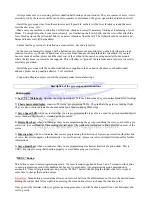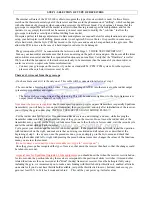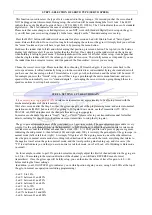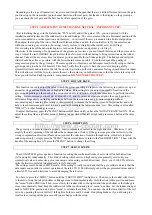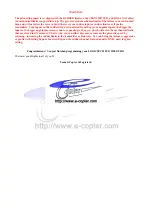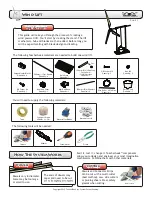
Depending on the type of transmitter / receiver used, it might happen that there is a little difference between the gain
you did setup in the transmitter ( gain channel limits) and the real gain, but thanks to the display on the gyroscope,
you can check the real gain and the Tail Lock or Rate operation of the gyro.
STEP 4: ADJUSTMENT OF MECHANICAL NEUTRAL – IMPORTANT STEP-
After initializing the gyro in the Rate mode( "TL" Led off) and set the gain at 30%, you can proceed with the
installation and adjustment of the rudder servo arm and linkage. The servo arm must be in a horizontal position if the
servo is mounted in a vertical position, and therefore… to vertical if the servo is mounted in a horizontal position.
Then adjust the length of the rod so that the tail blades anti have a pitch that would allow to fly in normal mode,
without any mixing or correction ( hovering) totally or close to straight on the rudder axis ( no drifting)
If ever during take off the helicopter begins to turn on itself quicker and quicker, go to Step 5.
Otherwise, if the meaning of compensation of the gyroscope is correct, you can finnish this step and then move on to
step 6. Adjust the tail LINKAGE length to allow the heli to hover without having to bring corrections on the rudder
channel. Take all the necessary time to adjust as good as possible the tail linkage length. The linkage and tail pitch
slider should be as free as possible, with the fewest hard point as possible. From there depend the quality of
compensation given by the gyroscope. The same applies to vibration, your helicopter must be fully setup so that the
gyroscope can give the best of himself. This Step 5 will allow the gyro to have the servo arm keeping a fully
symmetrical travel and outputs to the tail for a perfect operation, both sides, and same feeling in each direction inputs.
This will allow as well the Gyro to operate the servo the same way in both directions so that the rotate rate setup will
be as good for left and right operation / compensation.
DO NOT MISS THIS STEP !
STEP 5: ROTATE RATE
This function is used to adjust the rate at which the gyroscope will give inputs to the tail servo, in order to set up net
pirouettes stops and enable the use of high gain values. This setting lets you adjust the speed of reaction of the
gyroscope depending on the speed of the servo used and its installation. It will take some time to perfectly tune this
setting , we recommend you to set up a value of 2 or 3, and if you are an experienced pilot, then you have to try
different settings until you find a good balance between the reaction rate and pirouettes stopping without
encountering any bouncing (this setting is used primarily to remove the bouncing issues in fast pirouettes and will
help to reach maximum gain level to have a good tail holding in the fastest manoeuvres). This setting is also called
"DELAY" on other brands gyroscopes.
To adjust this feature, press the "MENU" button several times until you have the "ROTATE RATE” led ON. Then,
adjust the setting like on all other menus ( holding rudder stick either left or right and press menu button at the same
time).
STEP 6: DIRECTION
The gyroscope, in order to operate properly, must compensate or correct in the right direction. Otherwise, it will
amplify the drift / spinning of the tail rather than compensate or lock it. If the gyroscope gives the tail servo to the
wrong compensation direction (Please do not confuse the direction of rotation through radio, which acts for pilot
rudder inputs only), simply press the "MENU" button several times to turn on the "led DIRECTION." Then, with the
handle of the anti-right or left, press the "MENU" button to change the setting.
STEP 7: SERVO LIMITS
Your LOGICTECH gyroscope has a function for setting the mechanical limits of servo travel for both directions
( left and right), independently. This kind of setting which exists on high ends gyros generally exists only as a
symmetrical value on same size gyros (one unique value acting on both directions). Here, your 2100 LTG offers to
settle the limits completely independently for left, and right.
The settings must be done in RATE mode. If the setting is really too odd and that the gyro software detects that the
data inputs can not allow a correct operation of the tail, LTG 2100 will simply cancel the programmed values and set
a limit of 25% in each directions to avoid damaging the tail servo.
You have to press the "MENU" button until the "SERVO LIMIT" led lights on. Then, move the rudder stick slowly
to the left to bring the tail pitch slider or linkage close to bind mechanically. Hold the stick in this position and press
the “menu” button ONE time. Then, move slowly the rudder stick to the right untiul the pitch slider or the linkage is
close to mechanically bind, keep the rudder stick in that position and press “ menu” one time. Let the rudder stick get
back to NEUTRAL position, and press “menu” to validate the setting. You can now check the travel limits of the tail
servo by operating the stick full left / full right in both rate and TL mode. If anything binds or if you did setup too
small values, just repeat the process until you are happy with the setup.


